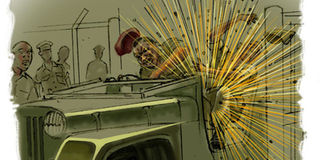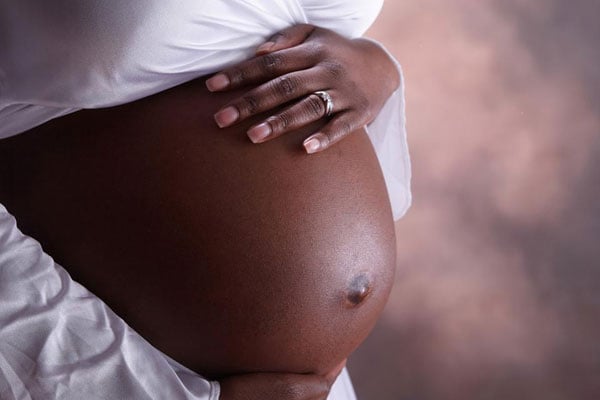Prime
When Obote, Amin survived assassination

An illustration of a bomb going off inside Idi Amin’s jeep.PHOTO/ILLUSTRATION/FILE
What you need to know:
- While the would-be assassin of president Obote was arrested and successfully prosecuted and convicted, the would-be assassin of Gen Amin was never arrested and to this day has not been identified.
When Gen Katumba Wamala survived an attempt on his life, he said God had given him a second chance in life. True. Because his driver and daughter were not as lucky. The would-be assassins riding on two motorcycles, using automatic rifles shot 56 bullets at the General’s car, killing his daughter and the driver.
Gen Katumba survived with bullets that tore through both arms in the mid-morning attack at Kisaasi, a Kampala suburb.
Similarly, two former presidents of Uganda, Apollo Milton Obote and Idi Amin, also survived attempts on their lives in Kampala.
While the would-be assassin of president Obote was arrested and successfully prosecuted and convicted, the would-be assassin of Gen Amin was never arrested and to this day has not been identified. It is presumed that the would-be assassin was among the bystanders killed by security men during the shooting that ensued.
How Obote survived
On December 19, 1969, Obote survived an attempt on his life. Had the pistol not jammed, today, the country’s history would be reading otherwise. But why did the would-be assassin choose December 19?
It was the closing day of the Uganda Peoples Congress (UPC) party annual delegates’ conference at Lugogo Indoor stadium in Kampala. The conference lasted three days with presidents Julius Nyerere of Tanzania, Kenneth Kaunda of Zambia, and Mobutu Sese Seko of Zaire, now DR Congo, gracing the opening day, but returned home thereafter.
Benedicto hired would-be assassin
When Obote was shot at, from the top military and government circles, army commander Maj Gen Idi Amin was suspected to be the would-be assassin. Gen Amin was suspected because there had been bad blood between him and Dr Obote since late 1968. But when the Flying Squad swung into action, in just hours, the trail led police investigators to Benedicto Kiwanuka, Uganda’s first Prime Minister and leader of the Democratic Party (DP).
Kiwanuka was a World War I veteran sergeant.
The director of Criminal Investigations Department (CID), Mr Mohamed Hassan, personally led the investigations.
In less than 24 hours, the first suspect, Mohamed Sebaduka, a Kampala-based taxi driver, was netted from his hideout in Natete, a Kampala City suburb.
Upon interrogation, Sebaduka revealed it all. While testifying before the High Court in Kampala, the CID boss said Kiwanuka had imported the firearms from the Soviet Union purposely to assassinate Obote. The plot was first hatched in June 1969. He said in Masaka, Benedicto recruited Yusuf Kisule aged 67 in 1969. Kisule in turn recruited Yowana Wamala and Mohamed Sebaduka, the would-be assassin.
Sebaduka was a Kampala-based taxi driver and a radical Muslim. He was also an ex-service man who had been dismissed from the Uganda Army after the 1966 Lubiri Crisis. The CID boss also told court that during interrogation, six men, including Sebaduka, confessed that Benedicto met Sebaduka, Wamala and Princess Ndagire, Kabaka Muteesa’s daughter, at her home in Kampala on the morning of December 19, 1969, for the last briefing of the execution of the mission.
A day before, Kisule had managed to bring the firearms, which included a Czechoslovakia-made pistol and a hand grenade to Kampala from Masaka.
Obote jumps his grave
It was about a quarter to 10pm, when President Obote left the hall and walked towards his car. Next to him was his Principal Private Secretary Henry Kyemba. Amid the blaring music from the army brass band, everyone was clapping and singing along, without anyone suspecting any danger.
But history was about to record that Uganda’s president survived assassination. But like the adage goes: “When your time has not come, you will jump your grave.” Indeed, Obote jumped his grave, but not without injuries, physical and psychological scars.
Sebaduka pulls the trigger
From behind a cypress tree, about 10 metres from Obote, with maximum precision, Sebaduka aimed and fired his pistol. It is not clear how many bullets were in the pistol and how many he intended to pump into Obote’s head, but during the interrogation and before the court, Sebaduka said after the first bullet, the pistol jammed.
But the first bullet blasted through Obote’s mouth, broke two teeth and went through the cheek, and grazed Obote’s principal private secretary’s neck.
Seeing that Sebaduka’s pistol had jammed, Wamala hurled a grenade at Obote. But miraculously, it also did not explode.
As Obote’s bodyguards flung him down to protect him from more bullets, Sebaduka dropped his gun and attempted to sprint away, but someone grabbed him and he was handled over to security personnel.
One of the infuriated Obote’s bodyguards wanted to kill him. He shot Sebaduka twice.
“I remember there was someone from the president’s security who wanted to shoot the man who had shot Obote. But I told security not to kill him because he would help us with investigations. Unfortunately, during that stampede that followed, the would-be assassin escaped, but was rearrested by police,” Kyemba told this newspaper in 2018.
In the ensuing stampede, Sebaduka melted away in the crowd. Wamala snatched the pistol and hid it in the branches of the cypress tree that had given Sebaduka cover.
When police investigators arrived at the scene, they found the hidden pistol and on it, Wamala’s fingerprints that would incriminate him.
Police rearrest Sebaduka
During the court hearing, the CID boss revealed that the would-be assassin had earlier stolen an Anglia car to be used as the getaway car. Sebaduka had also altered the stolen car registration number plate to confuse the authority in case of investigations.
Although Sebaduka managed to drive off from the scene of crime in the getaway car, police investigators were able to capture him because he had left a trail of blood. From Lugogo, police trailed him up to Natete where he was re-arrested.
Sebaduka had burnt the car in attempt to destroy evidence. But police had in fact picked on the car as suspected evidence before arresting Sebaduka.
Incredibly, Sebaduka and five others involved where arrested in less than 24 hours.
On December 20, 1969, Kiwanuka and several other suspects, many members of DP, were arrested and incarcerated at the Maximum Security Prison, Luzira, where they remained; and were only released by president Amin after the 1971 coup in which the army ousted Obote.
Amin survives assassin’s grenade
On June 10, 1976, President Amin too survived an attempt on his life by a hairbreadth when a grenade was tossed at his presidential jeep.
To this day, the would-be assassin has never been identified. It is believed that the would-be assassin was among the people killed in the random shooting that ensued after the grenade exploded inside the jeep.
It was about 7.30pm when Amin exited Nsambya Police Barracks in Kampala and headed to Entebbe State House after attending a police function.
As his jeep reached the gate, the would-be assassin hurled a grenade into it. If Amin had been in the co-driver’s seat, he would have been assassinated.
As Amin entered the barracks, he was in the co-driver’s seat, which was on left side of the gate. But on coming out, Amin decided to drive himself out while his driver, Sgt Musa Abbas, took the co-driver’s seat.
When the jeep slowed down at the gate, the assassin flung the grenade onto the co-driver’s seat on the assumption that Amin had occupied it. The grenade exploded and seriously injured the driver. In rapid reaction, Amin got off his seat, picked Abbas and placed him on his lap.
Former government and army spokesperson Edrisa Mayanja Njuki, who was the third person in the jeep, but miraculously survived without any injuries talked to Sunday Monitor in 2019.
“I was trembling and at first I could not stand by myself. I remember Amin gave me two weeks to recover from the shock,” Njuki recalled. “Amin, without any escort, drove very fast to Mulago hospital. We followed him to Mulago. We found Amin inside the ward attending to Abbas with the doctors and nurses.”
Abbas succumbed to the deep injuries he had sustained. He passed on after four days.
Abbas, who was from West Nile, just like Amin, was buried at Kololo Military Cemetery in Kampala.
Benedicto accused
When Obote was shot at, from the top military and government circles, army commander Maj Gen Idi Amin was suspected to be the would-be assassin. Gen Amin was suspected because there had been bad blood between him and Dr Obote since late 1968.
But when the Flying Squad swung into action, in just hours, the trail led police investigators to Benedicto Kiwanuka, Uganda’s first Prime Minister and leader of the Democratic Party (DP). Kiwanuka was a World War I veteran sergeant.




